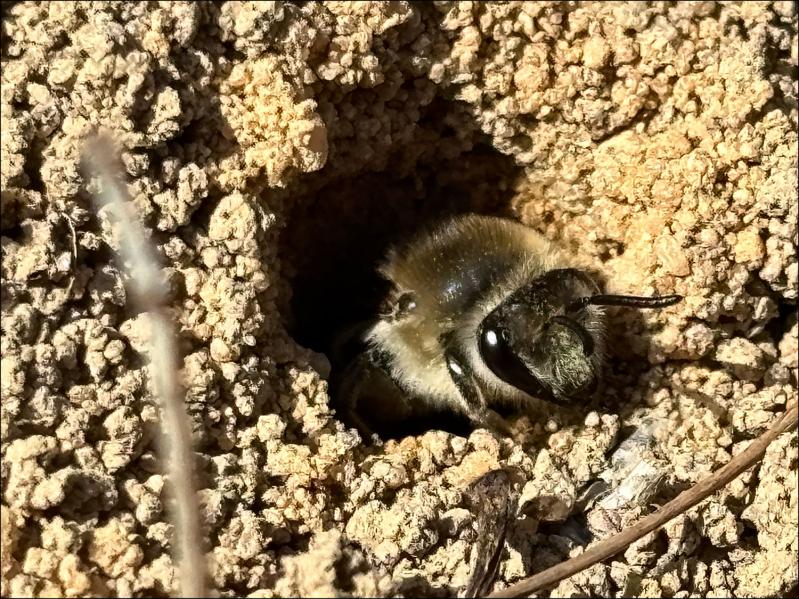Recently, I found myself crawling under the large maple tree in my front yard. Hundreds of small mounds with holes, each the diameter of a pencil, surrounded me. Above them zigging, dark, smallish bees traced incomprehensible patterns through the air: cellophane bees. I was enthralled.
The mounds, which for the last 25 years of my ignorant human life, I had believed to be anthills, were the entrances to their homes. Many holes were partially plugged by the presence of a female bee, who was quick to retreat if I made the slightest movement. To observe them properly, I just had to sit there, still and silent.
Of course, this made it impossible to ignore the teams of landscapers on nearby properties, loudly and tightly gift-wrapping nature. “If only they knew about the cellophane bees,” I thought, allowing myself to dream for a second.
“No, they’d keep on blowing,” I concluded.
Perhaps I’m wrong.
When humans discuss bees, often they’re talking about honeybees, or getting stung. However, according to the Xerces Society, over 450 other bee species live in the eastern United States, 90 percent of the world’s bees are solitary, and 70 percent live underground. Many, like the cellophane bee, are not aggressive and seldom sting.
Long before we started carting honeybees around to pollinate monocrops and selling their honey, native bees managed the task of pollinating specific plants and trees.
Honeybees, as we know, are having trouble. To help us money-obsessed humans, the Xerces Society uses a stock market analogy to describe the situation.
“For the same reason that diversified investing is safer than dependence on a single stock,” reads a line in its publication “Wild Pollinators of Eastern Apple Orchards & How to Conserve Them,” “relying on a single pollinator may pose increasing risk.”
“This is the height of their nesting period,” Daniel Gilrein, an entomologist and associate agricultural program director for the Cornell Cooperative Extension in Suffolk, said of the cellophane bee. That was in mid-April. By now they’re already starting to close up shop.
They get their name from the cellophane-like balloons they construct underground, which encase their larvae. The bees are solitary, in a way. While each lives in its own “house,” if they find good habitat, like under my maple tree, they build developments.
The females wait for the males to land and mate. Her nest extends underground from the hole and consists of a main shaft off of which she builds a few rooms. “They provision these chambers with a mix of pollen and nectar and lay a single egg in each,” the Xerces Society tells us. “The egg is sealed off in the chamber and develops into a larva, then a pupa. After months underground, when its flight period returns, the adult solitary bee will dig its way out of the nest and restart the cycle.”
When I started birding, nearly 25 years ago, I had the inkling that it was a slippery slope that ended in a huge, fertile plain, full of plants and insects. If you end up liking birds, you end up learning about what they eat (many insects) and where they nest (grass, trees).
For example, there were stories of birders who discovered moths and never returned to birds.
You’d hear about them hanging out in bogs at night, with sheets and lights.
Now, here I was crawling around staring down bee holes.
Life is funny.
Here are a few tree species that could attract these friendly pollinators to your property: red maple, redbud, shadbush (also known as serviceberry), and sweet crabapple. Mine buzzed around tiny blooms on whitlow grass. They also pollinate crocus flowers.
“They like well-drained areas. Sunny sites that warm up in the morning, and there needs to be food around,” said Mr. Gilrein. They can’t, or won’t, dig through a tight carpet of sod. So, embrace imperfection, or a new aesthetic. This bee needs a bare spot of dirt here and there.
As I said, they’re already slowing down. However, many other pollinators are starting to show. Bumble bees are dopily buzzing about and every day it seems a new shoot of green emerges from somewhere. Rest assured, the choreography of nature is at work and some insect, noticed by us humans or not, will soon visit the new growth, either for a bite to eat, or to pollinate. Soon after, that same insect may be eaten by a bird, or in a few weeks, fed to its nestlings.
“It’s amazing to see a bee out this early when not much is blooming,” said Mr. Gilrein. “Outdoor landscapes can serve as our other living room. It’s worth thinking about before regrading and disrupting things. Look around and you may notice things that are worth preserving.”

